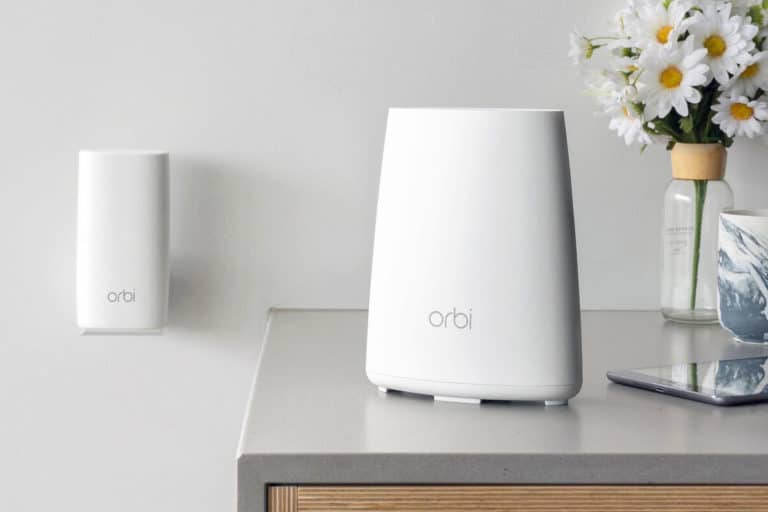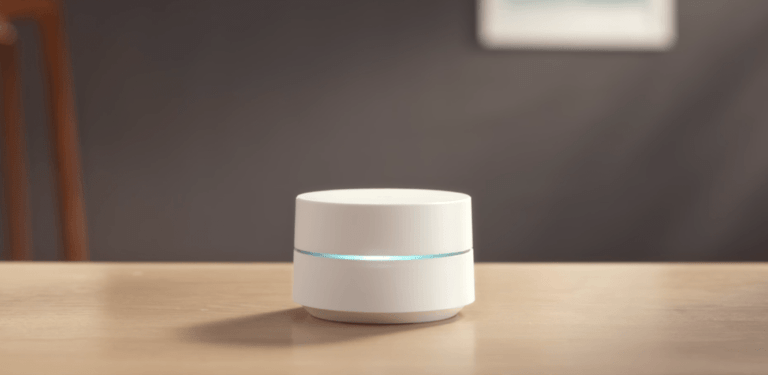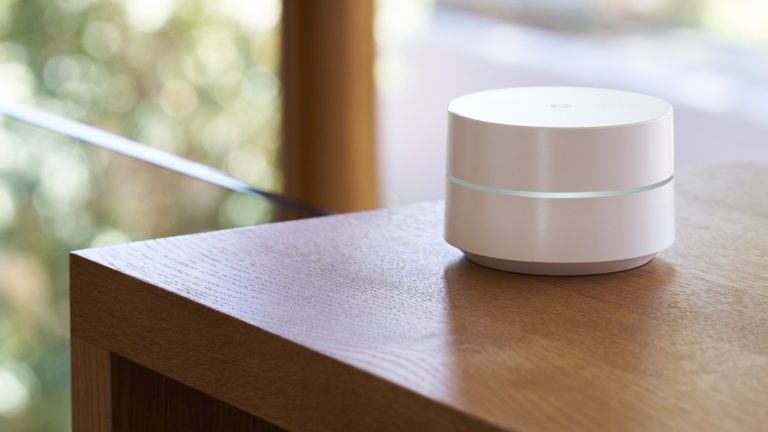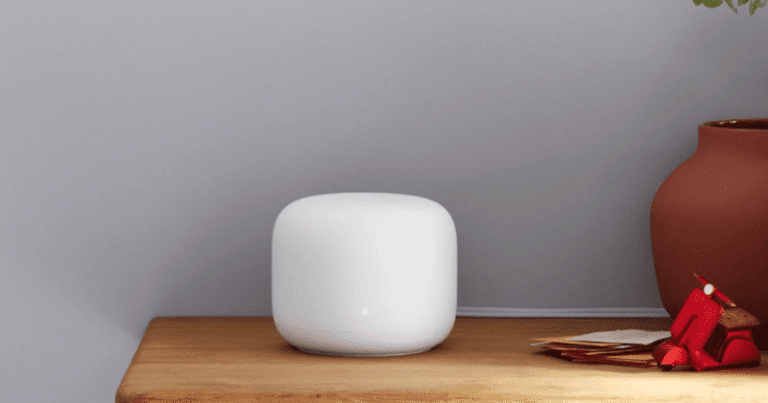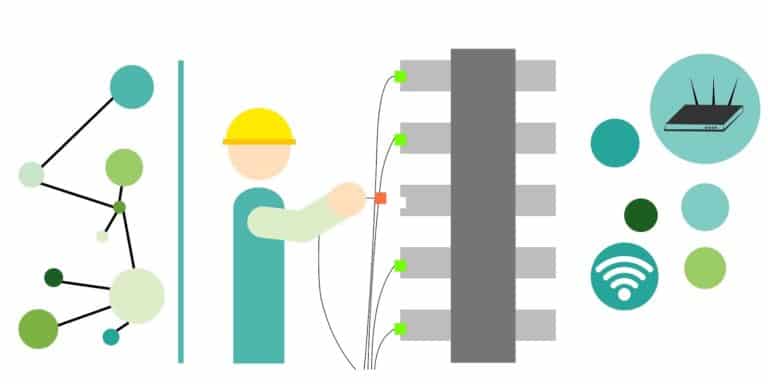Eero 6+ vs Eero Pro 6E: Should You Get a Wi-Fi 6E Mesh System?

Mesh Wi-Fi systems are the best solution to your home’s internet connection problems. But between Eero 6+ vs Eero Pro 6E, which is a better option?
Choosing the best mesh network for your home can be tricky. So, we’ll stack these two against each other in terms of performance, features, design, pros, and cons.
For us, the Eero 6+ is the overall best choice. It’s fast, stable, and reliable. But if you want to future-proof your home with the latest Wi-Fi 6E technology, then you’d enjoy the Eero Pro 6E. After all, it came out as the top performer in our roundup of the best routers eero makes.
Let’s get down to business and see which is the best mesh router for you.
Table of Contents
Comparison Overview
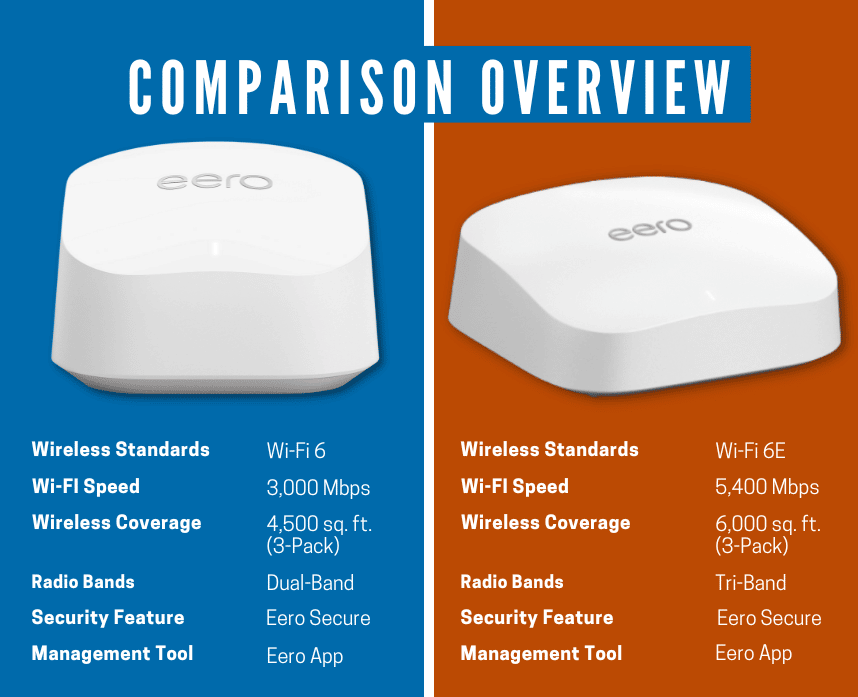
| SPECIFICATION | 6 Plus | 6E |
| Wireless Standards | Wi-Fi 6 | Wi-Fi 6E |
| Wi-FI Speed | 3,000 Mbps | 5,400 Mbps |
| Wireless Coverage | 4,500 sq. ft. (3-Pack) | 6,000 sq. ft. (3-Pack) |
| Radio Bands | Dual-Band | Tri-Band |
| Security Feature | Eero Secure | Eero Secure |
| Management Tool | Eero App | Eero App |
The Eero 6+ is a dual band mesh system that supports gigabit speeds. It has a maximum throughput of 3,000 as it’s powered with AX3000.
Even though it’s a dual-band router, it’s powerful enough to support 75 devices. On top of that, it supports 160MHz channels.
It allows this unit to process data faster and makes the wireless communication between Eero devices smoother and faster. This is the 6 Plus’ edge over the Pro 6E.
Meanwhile, the Eero Pro 6E is a tri-band mesh router that supports the latest Wi-Fi 6E technology. It means, instead of having two 5GHz bands, it has a 6GHz band that offers lightning-fast speeds.
So, this unit has the following radio frequencies:
- 2.4 GHz
- 5 GHz
- 6 GHz
Additionally, its 2.5 gigabit ethernet port makes wired connections fast and prevents data congestion. It supports gigabit speeds, which is perfect for large homes and offices.
Both meshes support a built-in Zigbee smart home hub and Eero Secure. On top of that, the setup process on both units is pretty easy and user-friendly.
When you purchase either of the two, you’ll get
- The Eero unit
- USB-C power cable
- LAN cable
- User manual
What’s important to remember is, the Pro 6E doesn’t come with extenders. If you buy a 3-pack kit, you’ll get 3 Pro 6E units.
But, there’s a catch. If you don’t want to spend that much money, the Eero Pro 6E is backward compatible. So you can connect older generation Eero models to function as mesh extenders. It’s cost-effective and environment-friendly!
Performance
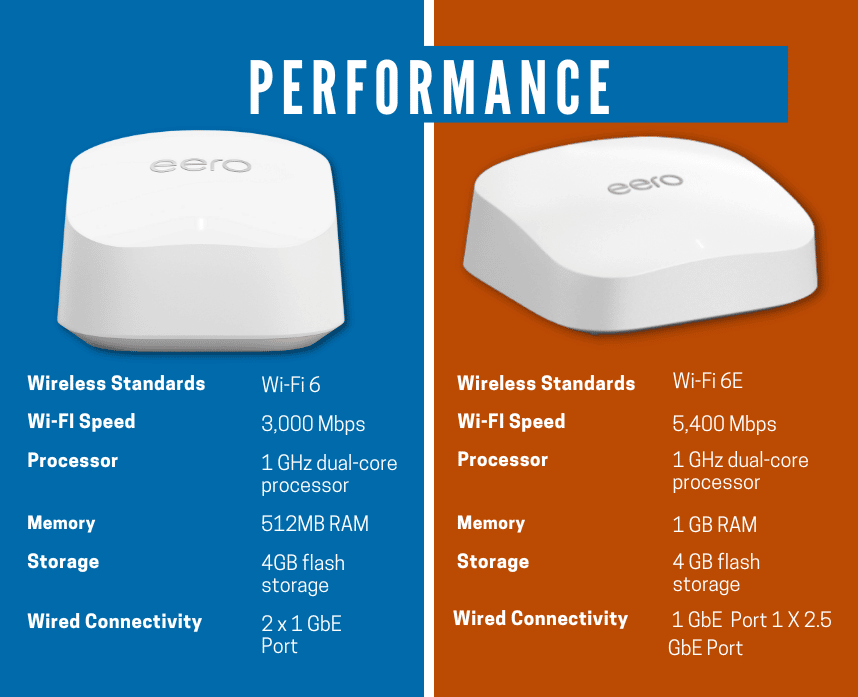
| SPECIFICATION | 66 Plus | 6E |
| Wireless Standards | Wi-Fi 6 | Wi-Fi 6E |
| Wi-FI Speed | 3,000 Mbps | 5,400 Mbps |
| Processor | 1 GHz dual-core processor | 1 GHz dual-core processor |
| Memory | 512MB RAM | 1 GB RAM |
| Storage | 4GB flash storage | 4 GB flash storage |
| Wired Connectivity | 2 x 1 Gigabit Ethernet Port | 1 Gigabit Ethernet Port 1 X 2.5 Gigabit Ethernet Port |
To see which is better in terms of performance, we’ve put each mesh router to the test. Let’s find out how each mesh performs on a wired and wireless backhaul.
For Eero 6 Plus, we used a Wi-Fi 6 device. Then for the Pro 6E, we used a Wi-Fi 6E-compatible device.
Here’s what we found out:
Eero 6+
The Eero 6 Plus promises to support gigabit speeds. Even though it didn’t really meet the expectations, it didn’t disappoint either.
The iPhone 13 Pro Max got stable speeds of up to 980 Mbps on a wired backhaul connection. So, this will still let you stream 4K videos, play online games, or just do regular internet browsing.
What’s striking about the 6 Plus is the wireless backhaul. Normally, speeds on the wireless backhaul drop drastically. But on the 6+, the speeds range from 600 – 400 Mbps.
These speeds are almost up to par with the Pro 6E’s wireless backhaul.
In terms of wireless range performance, the 6 Plus did deliver as advertised. At 30 ft away from the mesh router, it still delivered 100 Mbps internet speeds.
If you’re living in a mid-sized or average-sized home, the Eero 6+ is an excellent choice. It’s also a great router for apartment living. The Eero 6+ is powerful, fast, and stable enough to support day-to-day online activities.
Read: Eero 6+ Review
Eero Pro 6E
According to Amazon, the Eero Pro 6E supports gigabit speeds. With the 2.5 GbE port, we expected faster speeds out of this unit.
Fast speeds we want, fast speeds we get.
On a wired backhaul, Wi-Fi 6E devices like the Samsung Galaxy S21 Ultra got internet speeds up to 1.4 Gbps. these speeds didn’t drop below 900 Mbps.
The speeds on Wi-Fi 6 devices are competitively fast, too! The iPhone 13 Pro Max got 990 – 700 Mbps. If you ask us, that’s pretty impressive!
With the wireless configuration, the numbers aren’t too far apart. Wi-Fi 6E devices can enjoy 600-500 Mbps while Wi-Fi 6 devices got 500-400 Mbps.
However, a noticeable drawback of the Pro 6E is the use of the multi-gig port. For a mesh router with 2.5 GbE, you should be getting way faster speeds than that. Since this unit only has 1 multi-gig port, you can’t get higher multi-gig speeds either.
So if you really want to maximize the 2.5 Gigabit port, you might need a 3rd party device or bus. It should have 2 or more multi-gig ports like the Asus GT-AXE16000 or the ZenWiFi Pro XT12.
Read: Eero Pro 6E Review
Features and Design
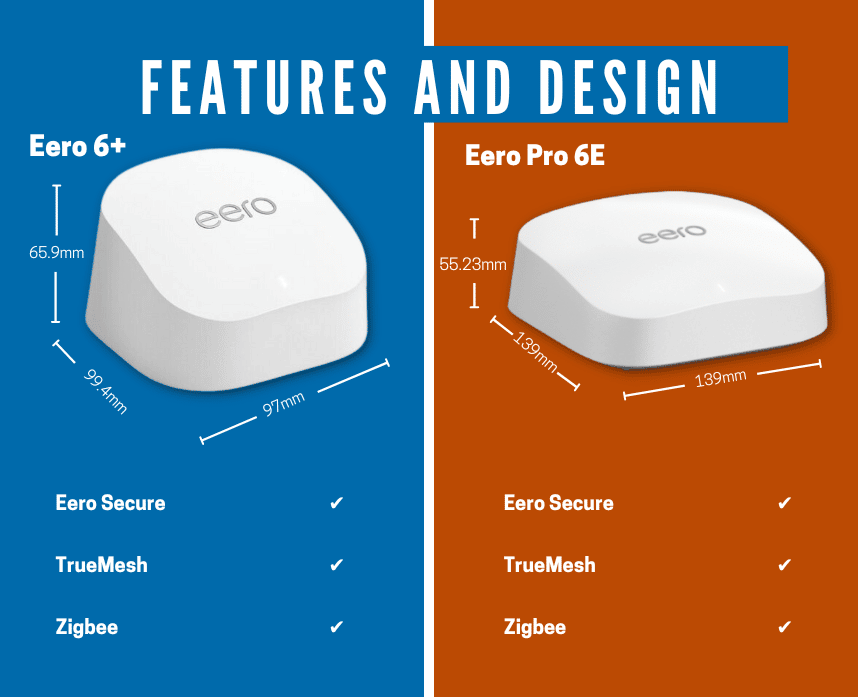
| SPECIFICATION | 6 Plus | 6+ |
| Dimension | L: 99.4mm x W: 97mm x H: 61.5 mm | L: 139 mm x W: 139mm x H: 55.23 mm |
| Eero Secure | ✔ | ✔ |
| TrueMesh | ✔ | ✔ |
| Zigbee | ✔ | ✔ |
Design-wise, both the Eero 6+ and eero Pro 6E have the signature white plastic case. They’re great for minimalist homes and plus, you can easily blend them in any home decor.
However, the Pro 6E is visibly bigger than the 6 Plus. But, it’s still a space-saver compared to other mesh systems out there.
Both mesh systems are protected by Eero Secure and Eero Secure Plus. It offers an additional layer of security for your home network.
Although these are extra costs, you’ll have the peace of mind knowing that your family is safe from online threats. With the extra parental controls, you can also monitor your family’s online activities.
On top of that, they also have a built-in Zigbee Home Hub. It lets you control your smart locks, thermostats, and other smart home devices through the app of Alexa voice commands.
Setup Process
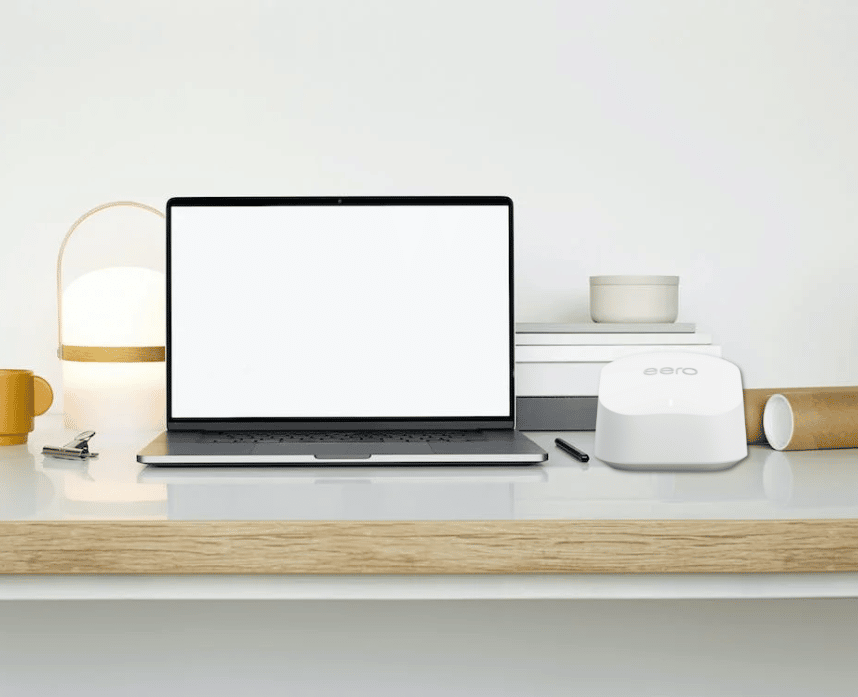
Eero is built for user convenience, and this doesn’t exclude the Pro 6E and the 6 Plus. The setup process is straightforward, making it best for beginners or non-techy lads.
The setup process starts once you download the Eero app on your android phone or iPhone device. Once you login using your Google or amazon account, the prompts on the app will guide you all the way.
You just need to prepare the following:
- Eero app
- Mobile phone with data
- Eero unit
- LAN cable
- Modem
- Active Bluetooth connection
Upon setting up your home network, your home is blanketed with seamless internet connection in no time!
Pros and Cons
Overall, both the Eero 6+ and Eero Pro 6E are awesome investments to keep your home blanketed with seamless connections. But, whether you should buy it or not depends on your preferences.
So here are the pros and cons of each mesh router and why you should get it or not.
Eero 6 Plus Pros and Cons
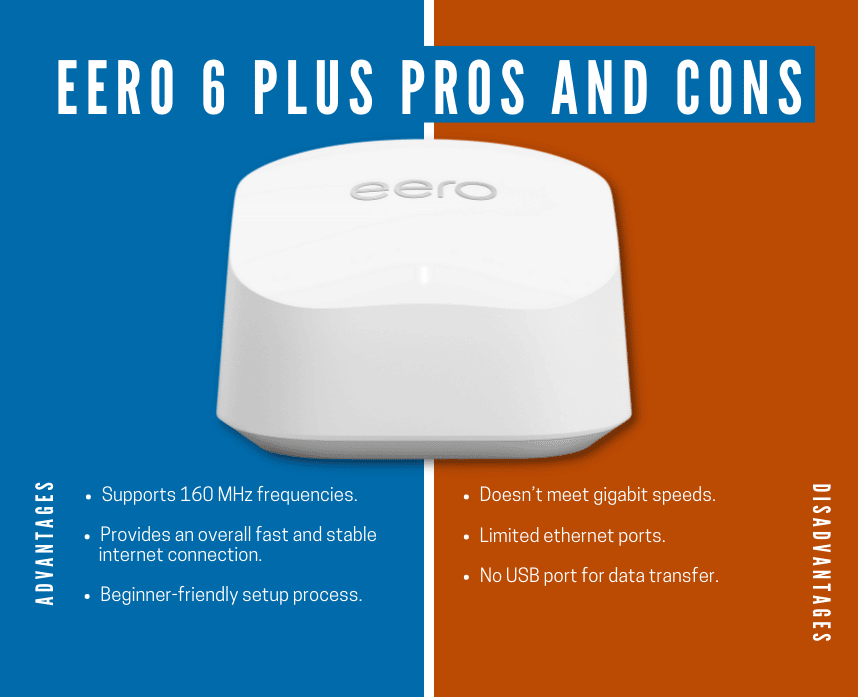
| PROS | CONS |
| Supports 160 MHz frequencies. | Doesn’t meet gigabit speeds. |
| Provides an overall fast and stable internet connection | Limited ethernet ports. |
| Beginner-friendly setup process. | No USB port for data transfer. |
Go ahead and buy the Eero 6 Plus if you want an efficient and fast mesh network in your home. It ticks all the boxes, plus even though it’s a dual-band, its performance is up to par with the Pro 6E.
It’s perfect for video streaming, online gaming, and regular browsing. Additionally, getting this unit is much more worth it if you have more WI-Fi 5 and 6 devices at home.
However, if you really want faster speeds for a larger space, then you can opt to get a different one.
Eero Pro 6E Pros and Cons
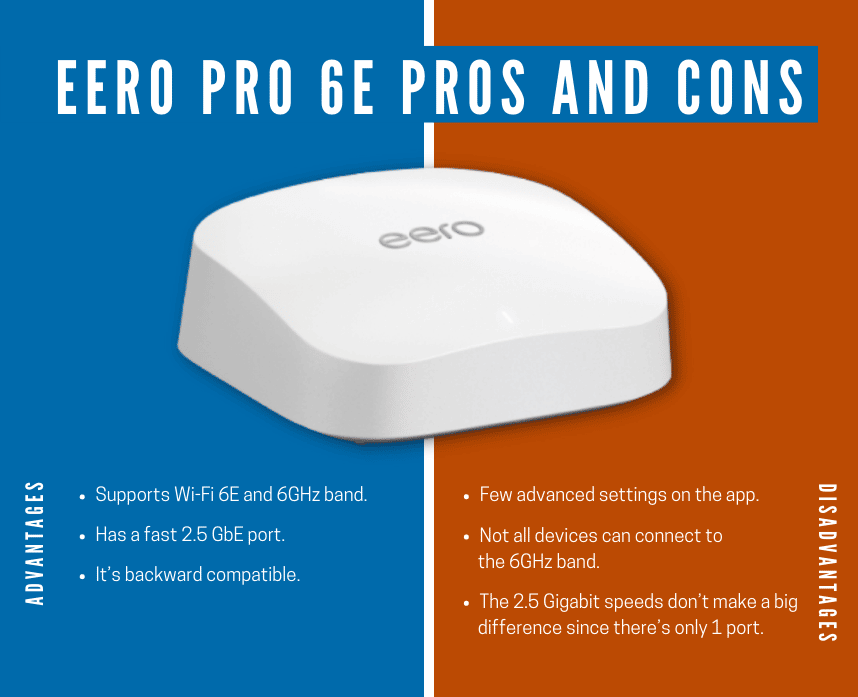
| PROS | CONS |
| Supports Wi-Fi 6E and 6GHz band. | Few advanced settings on the app. |
| Has a fast 2.5 GbE port. | Not all devices can connect to the 6GHz band. |
| It’s backward compatible. | The 2.5 Gigabit speeds don’t make a big difference since there’s only 1 port. |
Go ahead and get the Eero Pro 6E if you want to future-proof your smart home. It’s an excellent choice if you want to provide stable internet speeds to big houses and offices.
However, there aren’t many Wi-Fi 6E devices yet, so you can’t maximize its full potential and functionalities. This unit surely is ahead of its time, but that’s up to you to decide.
The Final Verdict: Eero 6+ Wins
Although the Eero Pro 6E is a great technological advancement, the Eero 6+ is a better option. It’s budget-friendly, plus it’s the best choice for all homes.
Upgrading your devices to the Wi-FI 6E technology isn’t a good move yet. Plus, it might take some time before gigabit speeds will be available in every single household.
Check out our full review of Eero 6+ here. Or get your own Eero 6+ and enjoy a sweet discount on Amazon here.
Related Articles:

